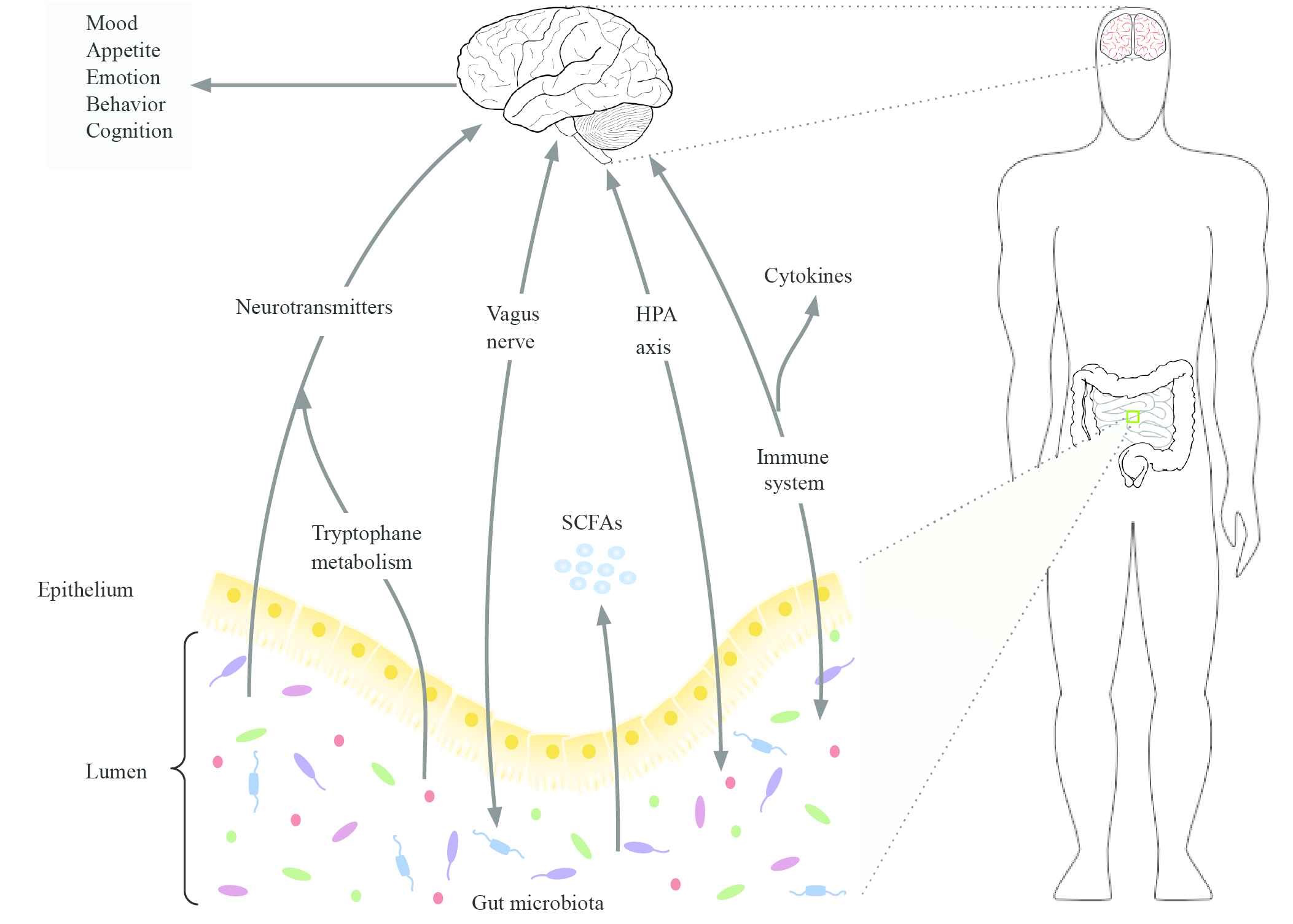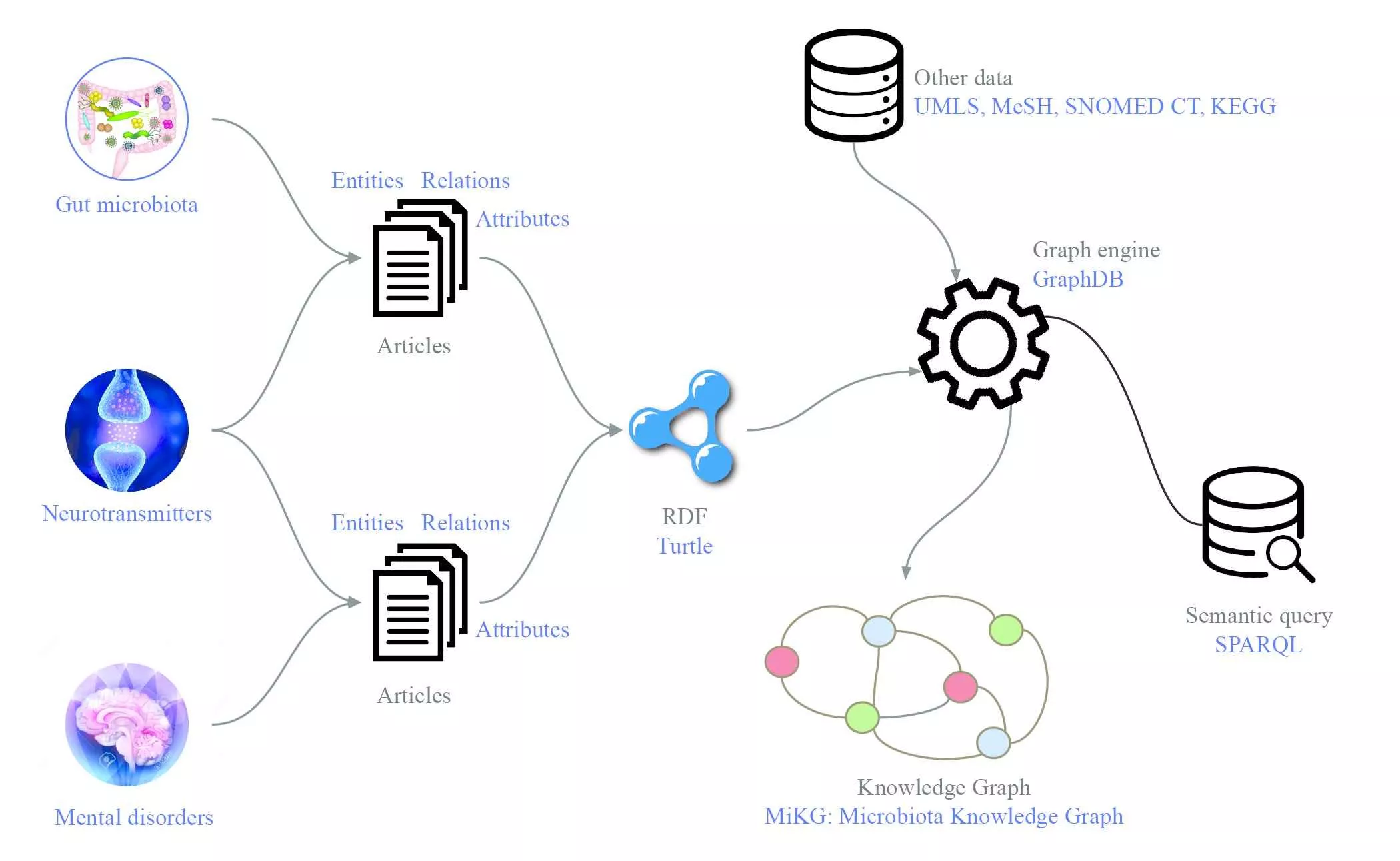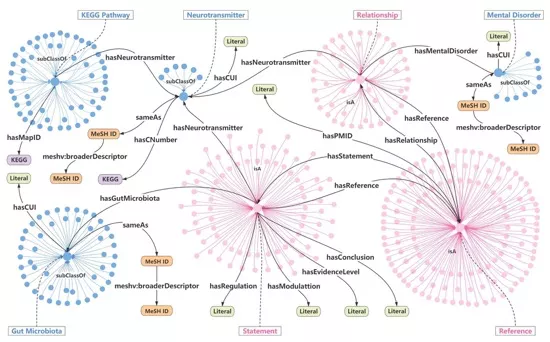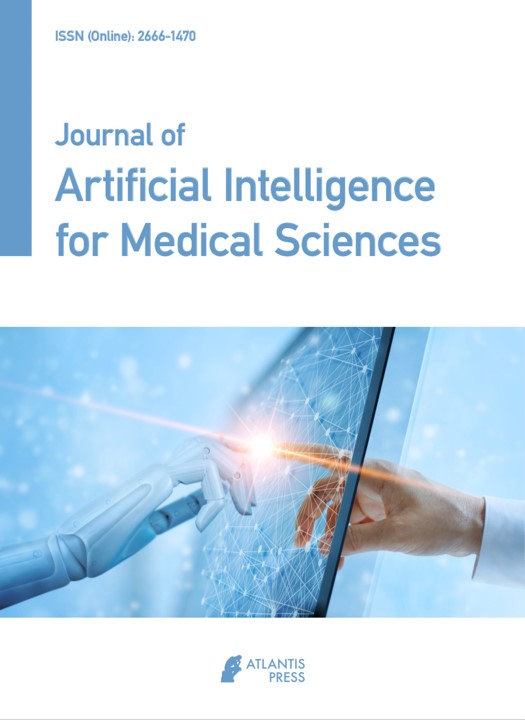博文
文章荐读 JAIMS | 知识图谱助力探索微生物-肠-脑轴与精神疾病的关系
 精选
精选
||
小编导读
在大脑-肠道的双向通讯系统中,肠道微生物是一项重要的载体,影响和干预神经、内分泌和免疫系统的信号传递途径。因此,“肠脑轴”被进一步延伸为“微生物-肠-脑(MGB)轴”。MGB轴在神经精神病学领域引起了研究者们极大的兴趣与关注。来自荷兰阿姆斯特丹自由大学的黄智生教授、刘婷博士等人在期刊Journal of Artificial Intelligence of Medical Sciences(eISSN 2666-1470)上发表了题为“Exploring the Microbiota-Gut-Brain Axis for Mental Disorders with Knowledge Graphs”的文章,用知识图谱技术探索肠道微生物通过调节神经递质而影响精神健康,由此进一步研究微生物-肠-脑轴与精神疾病的关系。
要点介绍
常见的精神障碍有抑郁症、焦虑症、饮食障碍、睡眠障碍、双相情感障碍、性行为障碍和孤独症等。根据世界卫生组织(WHO)的数据,大约五分之一的人在一生中都会遇到精神障碍。研究精神障碍的发病机制是治疗精神障碍的关键。
MGB轴为探索精神障碍的发病机制和制定合适的治疗策略提供了一条新的途径。肠道菌群通过肠-脑轴的通讯途径对脑部相关疾病有着重要影响,肠道微生物群可以产生多种神经递质。神经递质是一种化学物质,它影响着宿主的情绪、认知和行为,是调节MGB轴的关键部分。
为了深入研究肠道微生物群和神经递质在精神障碍发展中的作用,我们将现有研究的结果收集到一个结构化的知识库(即知识图谱)中。知识图谱是一个由实体和概念以及它们之间的语义关系组成的大规模语义网络,通过更快地搜索潜在的关系,从而支持做出更好的决策。知识图谱技术已经被应用于许多生物医学的实际问题,如从基于电子病历的知识图谱中学习高质量的知识,以及预测微生物与人类疾病之间的关系等。
在这篇论文中,我们提出了一个新的基于知识图谱的微生物群知识图来揭示肠道微生物群、神经递质和精神障碍之间的潜在关联,我们称之为MiKG。它包括许多连接到众所周知的生物医学本体知识库的接口,例如UMLS、MeSH、KEGG和SNOMED CT,并且可以通过连接到未来的本体库进行扩展,进一步研究肠道微生物群和神经递质之间的关系。
本研究的主要贡献如下:
1. 新的思路:将关于神经递质与肠道微生物关系研究的结果结构化到一个知识库。
2. 新的方法:以结构化的方式表达自由文本中肠道微生物、神经递质与精神疾病之间的语义关系,使之不仅人类可读且机器可读。3. 新的模型:以知识图谱挖掘肠道微生物与神经递质之间潜在关系,辅助未来研究。

图1. MGB轴图示。肠道微生物群通过肠道和大脑之间的双向信号影响宿主的健康状况。双向信号传递途径包括迷走神经、HPA轴、免疫系统、免疫系统产生细胞因子、分泌SCFAs、调节神经递质等。

图2. 构建知识图谱的工作流程。通过文献检索,我们收集了有关肠道微生物群与神经递质、神经递质与精神障碍关系的研究文献。其后提取实体、关系和属性,并将提取的数据结构化为RDF格式,与其他数据库:UMLS、MeSH、SNOMED CT和KEGG一起存储于GraphDB。GraphDB是一个提供SPARQL查询功能的平台。我们将知识图命名为MiKG。

图3. 知识图谱。蓝色和粉色的圆形簇分别代表TBox(术语)和ABox(推断)。箭头的标签标明特定的属性或关系,而箭头则表示属性或关系从源到目标的方向。概念通过CUI/MeSH ID链接到UMLS/MeSH,神经递质通过Map ID和C编号链接到KEGG数据库。
研究结论:为了预测肠道微生物群与精神障碍之间的关系,以神经递质为连接元素,我们首先以语义的方式整合现有生物医学研究中分散的知识,构建了一个知识图谱:MiKG。然后,我们设计了多个SPARQL查询用例以展示此知识图谱的检索和推理功能等。实验结果表明MiKG是揭示肠道微生物群、神经递质和精神障碍之间潜在联系的有力工具。它不仅有效地支持检索确定的关系,如肠道微生物群和神经递质之间的关系,而且能够推断出隐含的关系,如肠道微生物群通过神经递质对心理健康的影响。总之,MiKG是一个识别、检索和预测肠道微生物群、神经递质和精神障碍之间关系的有效工具。它有可能推断出合理的假设,从而加速开发新的治疗精神障碍的方法,并有利于未来对MGB轴的研究。
参考文献 References
[1] D. Vigo, G. Thornicroft, R. Atun, Estimating the true global bur- den of mental illness, Lancet Psychiatry. 3 (2016), 171–178.
[2] World Health Organization, Mental Disorders Affect One in Four People, World Health Report, World Health Organization, 2001.
[3] J. Lönnqvist, Major psychiatric disorders in suicide and suicide attempters, in: D. Wasserman, C. Wasserman (Eds.), Oxford Text- book of Suicidology and Suicide Prevention: A Global Perspec- tive, Oxford, UK: Oxford University Press, 2009, pp. 275–286.
[4] S. Bachmann, Epidemiology of suicide and the psychiatric per- spective, Int. J. Environ. Res. Public Health. 15 (2018), 1425.
[5] M. Thyloth, H. Singh, V. Subramanian, Increasing burden of mental illnesses across the globe: current status, Indian J. Soc. Psychiatry. 32 (2016), 254
[6] V. Patel, S. Saxena, C. Lund, G. Thornicroft, F. Baingana, P. Bolton, et al., The lancet commission on global mental health and sustainable development, Lancet. 392 (2018), 1553–1598.
[7] E.A. Mayer, R. Knight, S.K. Mazmanian, J.F. Cryan, K. Tillisch, Gut microbes and the brain: paradigm shift in neuroscience, J. Neurosci. 34 (2014), 15490–15496.
[8] Y. Wang, L.H. Kasper, The role of microbiome in central nervous system disorders, Brain Behav. Immun. 38 (2014), 1–12.
[9] J.F. Cryan, K.J. O’Riordan, C.S.M. Cowan, K.V. Sandhu, T.F.S. Bastiaanssen, M. Boehme, et al., The microbiota-gut-brain axis, Physiol. Rev. 99 (2019), 1877–2013.
[10] T.C. Fung, C.A. Olson, E.Y. Hsiao, Interactions between the microbiota, immune and nervous systems in health and disease, Nat. Neurosci. 20 (2017), 145.
[11] Y. Li, Y. Hao, B. Zhang, F. Fan, The role of microbiome in insomnia, circadian disturbance and depression, Front. Psychiatry. 9(2018), 669.
[12] P. Strandwitz, Neurotransmitter modulation by the gut micro-biota, Brain Res. 1693 (2018), 128–133.
[13] T. Liu, Z. Huang, Evidence-based analysis of neurotransmitter modulation by gut microbiota, in: H. Wang, S. Siuly, R. Zhou, F. Martin-Sanchez, Y. Zhang, Z. Huang (Eds.), International Con- ference on Health Information Science, Springer, Cham, Switzer- land, 2019, pp. 238–249.
[14] Y. Yang, Z. Huang, Y. Han, X. Hua, W. Tang, Using knowl- edge graph for analysis of neglected influencing factors of statin-induced myopathy, in: Y. Zeng et al. (Eds.), International Conference on Brain Informatics, Springer, Cham, Switzerland, 2017, pp. 304–311.
[15] A.Santos,A.R.Colaço,A.B.Nielsen,L.Niu,P.E.Geyer,F.Coscia,et al., Clinical knowledge graph integrates proteomics data into clinical decision-making, bioRxiv, 2020.
[16] L. Penev, M. Dimitrova, V. Senderov, G. Zhelezov, T. Georgiev, P. Stoev, K. Simov, Openbiodiv: a knowledge graph for literature- extracted linked open data in biodiversity science, Publications. 7 (2019), 38.
[17] O. Takaki, I. Takeuti, K. Takahashi, N. Izumi, K. Murata, M. Ikeda, K. Hasida, Graphical representation of quality indi- cators based on medical service ontology, SpringerPlus. 2 (2013), 274.
[18] S. Biswas, P. Mitra, K.S. Rao, Relation prediction of co-morbid diseases using knowledge graph completion, IEEE/ACM Trans. Comput. Biol. Bioinformat. 99 (2019). 1–1.
[19] H. Paulheim, Knowledge graph refinement: a survey of approaches and evaluation methods, Semantic Web. 8 (2017), 489–508.
[20] M.Rotmensch,Y.Halpern,A.Tlimat,S.Horng,D.Sontag,Learn- ing a health knowledge graph from electronic medical records, Sci. Rep. 7 (2017), 5994.
[21] Y.Janssens,J.Nielandt,A.Bronselaer,N.Debunne,F.Verbeke,E. Wynendaele, et al., Disbiome database: linking the microbiome to disease, BMC Microbiol. 18 (2018), 50.
[22] D.Collarana,M.Galkin,I.Traverso-Ribón,C.Lange,M.-E.Vidal, S. Auer, Semantic data integration for knowledge graph construc- tion at query time, in 2017 IEEE 11th International Conference on Semantic Computing (ICSC), IEEE, San Diego, CA, USA, 2017, pp. 109–116.
[23] J.Hastings,W.Ceusters,M.Jensen,K.Mulligan,B.Smith,Repre- senting mental functioning: ontologies for mental health and dis- ease, in Third International Conference on Biomedical Ontology, Graz, Austria, 2012, pp. 1–5. http://ontology.buffalo.edu/smith// articles/ICBO2012/MFO_Hastings.pdf
[24] V. Osadchiy, C.R. Martin, E.A. Mayer, The gut–brain axis and the microbiome: mechanisms and clinical implications. Clin. Gas- troenterol. Hepatol. 17 (2019), 322–332.
[25] M.Scriven,T.G.Dinan,J.F.Cryan,M.Wall,Neuropsychiatricdis- orders: influence of gut microbe to brain signalling, Diseases. 6 (2018), 78.
[26] D. Bzdok, A. Meyer-Lindenberg, Machine learning for precision psychiatry: opportunities and challenges, Biol. Psychiatry Cogn. Neurosci. Neuroimaging. 3 (2018), 223–230.
[27] V.K. Mehta, P.S. Deb, R.D. Subba, Application of computer tech- niques in medicine, Med. J. Armed Forces India. 50 (1994), 215– 218.
[28] M. Valles-Colomer, G. Falony, Y. Darzi, E.F. Tigchelaar, J. Wang, R.Y. Tito, et al., The neuroactive potential of the human gut micro- biota in quality of life and depression, Nat. Microbiol. 4 (2019), 623–632.
[29] P. Zheng, B. Zeng, C. Zhou, M. Liu, Z. Fang, X. Xu, et al., Gut microbiome remodeling induces depressive-like behaviors through a pathway mediated by the hosts metabolism, Mol. Psy- chiatry. 21 (2016), 786.
[30] J.A.Bravo,P.Forsythe,M.V.Chew,E.Escaravage,H.M.Savignac, T.G. Dinan, J. Bienenstock, J.F. Cryan, Ingestion of lactobacil- lus strain regulates emotional behavior and central gaba receptor expression in a mouse via the vagus nerve, Proc. Natl. Acad. Sci. 108 (2011), 16050–16055.
[31] W.-H. Liu, H.-L. Chuang, Y.-T. Huang, C.-C. Wu, G.-T. Chou, S. Wang, Y.-C. Tsai, Alteration of behavior and monoamine levels attributable to lactobacillus plantarum ps128 in germ-free mice, Behav. Brain Res. 298 (2016), 202–209.
[32] S.C. Kleiman, H.J. Watson, E.C. Bulik-Sullivan, E.Y. Huh, L.M. Tarantino, C.M. Bulik, I.M. Carroll, The intestinal microbiota in acute anorexia nervosa and during renourishment: relationship to depression, anxiety, and eating disorder psychopathology, Psy- chosom. Med. 77 (2015), 969.
[33] R.P. Smith, C. Easson, S.M. Lyle, R. Kapoor, C.P. Donnelly, E.J. Davidson, Gut microbiome diversity is associated with sleep phys- iology in humans, PloS One. 14 (2019), e0222394.
[34] C.E. Schretter, J. Vielmetter, I. Bartos, Z. Marka, S. Marka, S. Argade, S.K. Mazmanian, A gut microbial factor modulates loco- motor behaviour in drosophila, Nature. 563 (2018), 402.
[35] T. Liu, K. Anton Feenstra, J. Heringa, Z. Huang, Influence of gut microbiota on mental health via neurotransmitters: areview, J. Artif. Intell. Med. Sci. 1 (2020), 1–14.
[36] F. Özoğul, E. Kuley, Y. Özoğul, İ. Özoğul The function of lac- tic acid bacteria on biogenic amines production by food-borne pathogens in arginine decarboxylase broth, Food Sci. Technol. Res. 18 (2012), 795–804.
[37] A. Mayr, G. Hinterberger, M.P. Dierich, C. Lass-Flörl, Interaction of serotonin with candida albicans selectively attenuates fungal virulence in vitro, Int. J. Antimicrob. Agents. 26 (2005), 335–337.
[38] Y. Gezginc, I. Akyol, E. Kuley, F. Özogul, Biogenic amines for- mation in streptococcus thermophilus isolated from home-made natural yogurt, Food Chem. 138 (2013), 655–662.
[39] M.G. Strakhovskaia, E.V. Ivanova, G. Fraĭnkin, Stimulatory effect of serotonin on the growth of the yeast candida guilliermondii and the bacterium streptococcus faecalis, Mikrobiologiia. 62 (1993), 46–49.
[40] M. Lyte, Probiotics function mechanistically as delivery vehi- cles for neuroactive compounds: microbial endocrinology in the design and use of probiotics, Bioessays. 33 (2011), 574–581.
[41] E.A. Tsavkelova, I.V. Botvinko, V.S. Kudrin, A.V. Oleskin, Detec- tion of neurotransmitter amines in microorganisms with the use of high-performance liquid chromatography, Doklady Biochem. Proc. Acad. Sci. USSR. 372 (2000), 372 115.
[42] V.A. Shishov, T.A. Kirovskaya, V.S. Kudrin, A.V. Oleskin, Amine neuromediators, their precursors, and oxidation products in the culture of escherichia coli k-12, Appl. Biochem. Microbiol. 45 (2009), 494–497.
[43] M. Diaz, B. del Rio, V. Ladero, B. Redruello, M. Fernández, M.C. Martin, M.A. Alvarez, Isolation and typification of histamine- producing lactobacillus vaginalis strains from cheese, Int. J. Food Microbiol. 215 (2015), 117–123.
[44] R.P. Brown, J. John Mann, A clinical perspective on the role of neurotransmitters in mental disorders, Psychiatr. Serv. 36 (1985), 141–150.
[45] S. Jupp, T. Burdett, C. Leroy, H.E. Parkinson, A new ontol- ogy lookup service at embl-ebi, in SWAT4LS, Proceedings of SWAT4LS International Conference, Cambridge, UK, 2015, pp. 118–119. http://ceur- ws.org/Vol- 1546/paper_29.pdf
[46] G. Fragoso, S. de Coronado, M. Haber, F. Hartel, L. Wright, Overview and utilization of the NCIthesaurus, Int. J. Genomi. 5 (2004), 648–654.
[47] L.M. Schriml, C. Arze, S. Nadendla, Y.-W. Wayne Chang, M. Mazaitis, V. Felix, G. Feng, W.A. Kibbe, Disease ontology: a backbone for disease semantic integration, Nucleic Acids Res. 40 (2012), D940–D946.
[48] I.K. Dhammi, S. Kumar, Medical Subject Headings (MESH) terms, Indian J. Orthopaed. 48 (2014), 443.
[49] J. Kim, T.G.R. Macieira, S.L. Meyer, M. Ansell, R.I. Bjarnadottir, M.B. Smith, Towards implementing snomed ct in nursing prac- tice: a scoping review, Int. J. Med. Informat. 134 (2020), 104035.
[50] M.D. Wilkinson, M. Dumontier, I.J. Aalbersberg, G. Appleton, M. Axton, A. Baak, et al., The fair guiding principles for scientific data management and stewardship, Sci. Data. 3 (2016), 160018.
[51] Z. Huang, J. Yang, F. van Harmelen, Q. Hu, Constructing knowl- edge graphs of depression, in: S. Siuly et al. (Eds.), Conference on Health Information Science, Springer, Cham, Switzerland, 2017, pp. 149–161.
[52] S. Sang, Z. Yang, X. Liu, L. Wang, H. Lin, J. Wang, M. Dumontier, Gredel: a knowledge graph embedding based method for drug discovery from biomedical literatures, IEEE Access. 7 (2018), 8404–8415.
[53] S. Sakr, G. Al-Naymat, Relational processing of rdf queries: a sur- vey, ACM SIGMOD Record. 38 (2010), 23–28.
[54] O. Bodenreider, The Unified Medical Language System (UMLS): integrating biomedical terminology, Nucleic Acids Res. 32 (2004), D267–D270.
[55] M. Kanehisa, S. Goto, Kegg: kyoto encyclopedia of genes and genomes, Nucleic Acids Res. 28 (2000), 27–30.
[56] M.H. Coletti, H.L. Bleich, Medical subject headings used to search the biomedical literature, J. Am. Med. Informat. Assoc. 8 (2001), 317–323.
[57] L. Stanescu, D. Dan Burdescu, M. Brezovan, C.G. Mihai, Creat- ing New Medical Ontologies for Image Annotation: A Case Study, Springer Science & Business Media, New York, NY, USA, 2011.
[58] R.H. Güting, Graphdb: modeling and querying graphs in databases, in VLDB, Citeseer, VLDB ‘94, Proceedings of the 20th International Conference on Very Large Data Bases, Santiago de Chile, Chile, 1994, vol. 94, pp. 12–15. http://www.vldb.org/conf/ 1994/P297.PDF
[59] M. Arenas, J. Pérez, Querying semantic web data with sparql, in Proceedings of the Thirtieth ACM SIGMOD-SIGACT-SIGART Symposium on Principles of Database Systems, Athens, Greece, 2011, pp. 305–316.
[60] N. Guarino, D. Oberle, S. Staab, What is an ontology?, in: S. Staab, R. Studer (Eds.), Handbook on Ontologies, Springer, Cham, Switzerland, 2009, pp. 1–17.
[61] N. Achich, B. Bouaziz, Ontology visualization: an overview, in: A. Abraham, P. Muhuri, A. Muda, N. Gandhi (Eds.), Interna- tional Conference on Intelligent Systems Design and Applica- tions, Springer, Cham, Switzerland, 2017, pp. 880–891.
[62] Brachman, H.J. Levesque, R. Fikes, Krypton: integrating termi- nology and assertion, in AAAI, Proceedings of the National Con- ference on Artificial Intelligence, Washington, D.C. 1983, vol. 83, pp. 31–35.
[63] M. Schink, P.C. Konturek, E. Tietz, W. Dieterich, T.C. Pinzer, S. Wirtz, M.F. Neurath, Y Zopf, Microbial patterns in patients with histamine intolerance, J. Physiol. Pharmacol. 69 (2018), 579–593.
[64] B. Pugin, W. Barcik, P. Westermann, A. Heider, M. Wawrzyniak, P. Hellings, C.A. Akdis, L. OMahony, A wide diversity of bacte- ria from the human gut produces and degrades biogenic amines, Microb. Ecol. Health Dis. 28 (2017), 1353881.
[65] W. Barcik, M. Wawrzyniak, C.A. Akdis, L. OMahony, Immune regulation by histamine and histamine-secreting bacteria, Curr. Opin. Immunol. 48 (2017), 108–113.
[66] S.K. Mohamed, V. Nováček, A. Nounu, Discovering protein drug targets using knowledge graph embeddings, Bioinformatics. 36 (2020), 603–610.
[67] Y. Fang, H. Wang, L. Wang, R. Di, Y. Song, Diagnosis of copd based on a knowledge graph and integrated model, IEEE Access. 7 (2019), 46004–46013.
[68] E. Thursby, N. Juge, Introduction to the human gut microbiota, Biochem. J. 474 (2017), 1823–1836.
[69] M.S.C. Thomas, D. Mareschal, I. Dumontheil, Educational Neu- roscience: Development Across the Life Span, Routledge, Abing- don, United Kingdom, 2020.
[70] American Psychiatric Association, Diagnostic and Statistical Manual of Mental Disorders (DSM-5®), American Psychiatric Publishing, Washington, D.C. 2013.
原文信息
T. Liu, X. Pan, X. Wang, K. A. Feenstra, J. Heringa, Z. Huang, "Exploring the Microbiota-Gut-Brain Axis for Mental Disorders with Knowledge Graphs", Journal of Artificial Intelligence for Medical Sciences, 2021, DOI: 10.2991/jaims.d.201208.001.

扫描二维码,获取英文原文
https://www.atlantis-press.com/journals/jaims/125948765/
关于期刊

Journal of Artificial Intelligence of Medical Sciences (JAIMS,eISSN 2666-1470)是一本国际性的、经过严格同行评审的开放存取期刊,刊载人工智能在医学、医疗保健和生命科学所有交叉学科方向的理论,方法和应用的研究。编辑团队尤其欢迎在机器/深度学习、数据科学、自然语言处理(NLP)等支持下,为医学诊断、药物开发、护理、精准治疗等领域提供最近见解的原创性研究文章、综合评论、通信和观点。
JAIMS 由荷兰阿姆斯特丹自由大学黄智生教授担任创刊主编,来自八个国家的36名领域一流学者担任首届编委会,致力于将期刊打造为医学人工智能领域的首选阵地和开放科学平台。文章成果版权作者保留,不收取任何费用。欢迎各位专家投稿!
版权声明:
*本文内容由Atlantis Press中国办公室编辑。欢迎转发。如需转载,请在留言区留言,或联系xin.guo@atlantis-press.com
![]()
Atlantis Press是科学、技术和医学(STM)领域的全球开放获取出版品牌,2006年创立于法国巴黎,在巴黎、阿姆斯特丹、北京、郑州和香港设有办事处。我们的使命是通过促进科研界和整个社会更有效地传播和交流知识来支持科学、技术和医学研究的进步。迄今,Atlantis Press的数字内容平台包含超过14万篇开放获取论文供读者免费下载阅读,每年产生2500多万下载量。Atlantis Press是施普林格·自然的一部分。
https://blog.sciencenet.cn/blog-3453320-1285833.html
上一篇:文章荐读 JRACR | 煤层气产业化开发生态环境风险评估模型的构建
下一篇:文章荐读 Artery Research | 年轻剑道运动员的中心血压研究:无氧和力量联合训练的意义